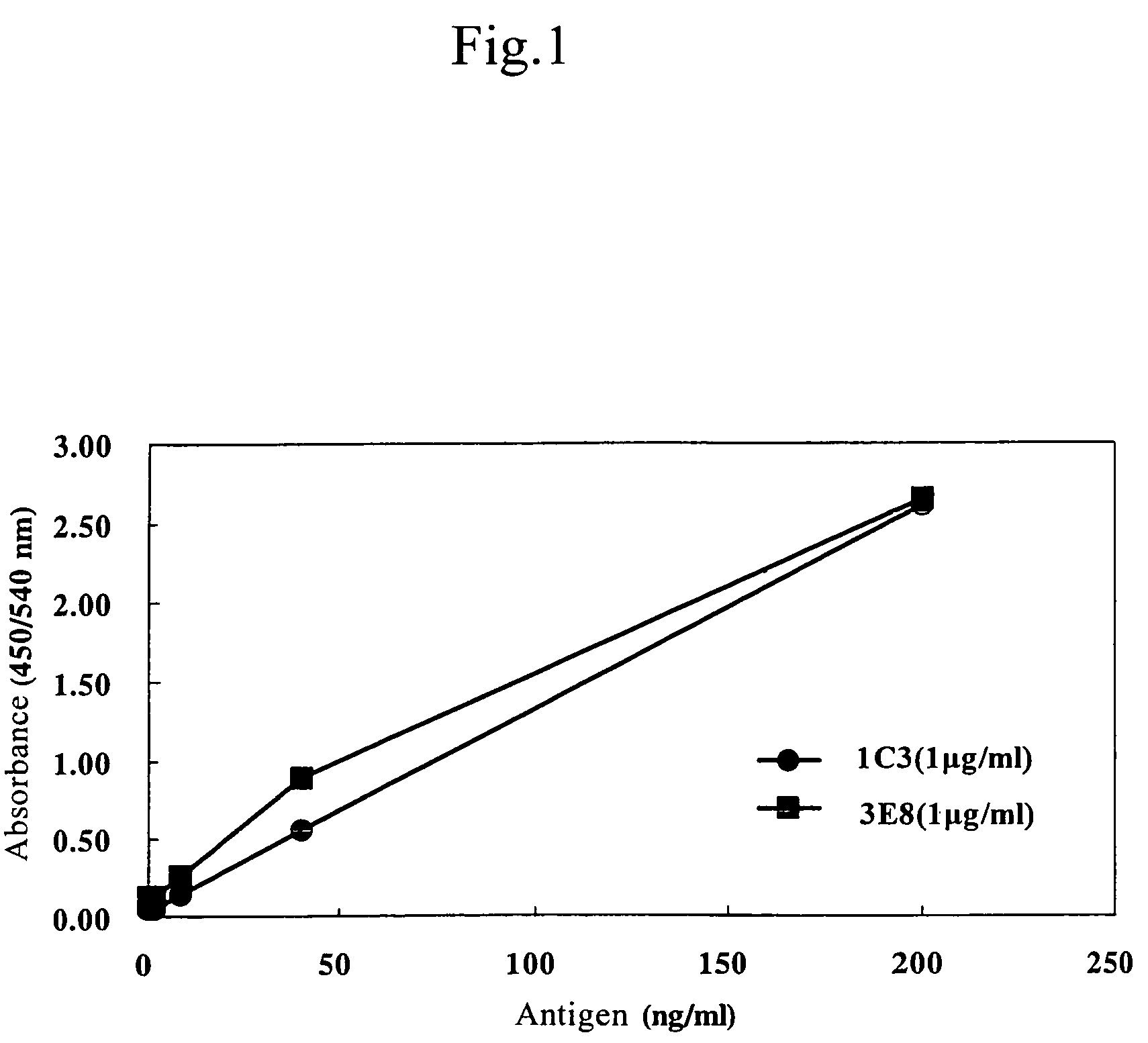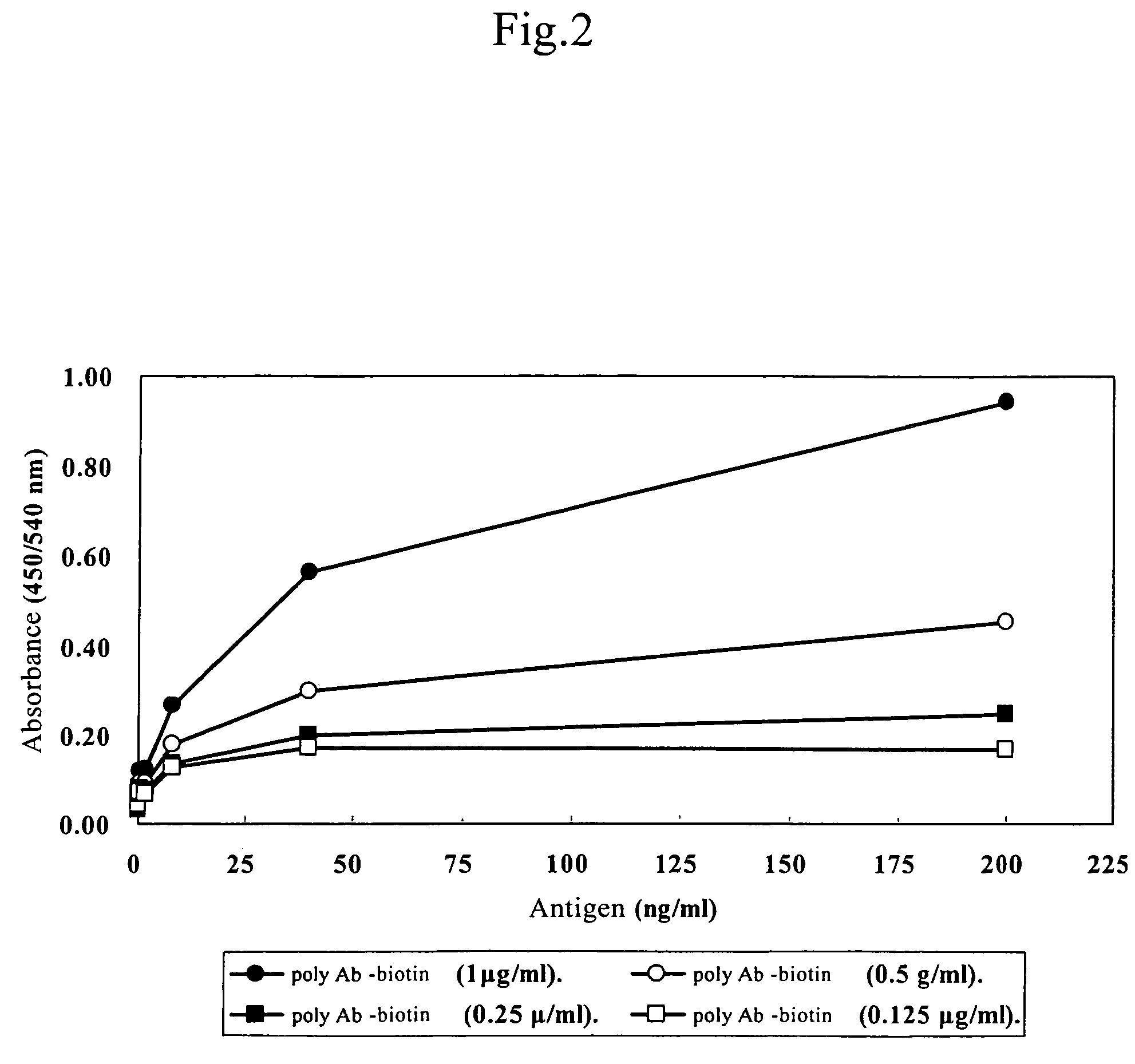Monoclonal antibody and hybridoma producing the same
a hybridoma and monoclonal antibody technology, applied in the field of monoclonal antibodies, can solve the problems of complex procedures, inability to differentiate human and mouse epr, and inability to detect epr in the living body, and achieve the effect of simple and highly sensitive detection methods
- Summary
- Abstract
- Description
- Claims
- Application Information
AI Technical Summary
Benefits of technology
Problems solved by technology
Method used
Image
Examples
example 1
Preparation of Hybridomas
[0055]One hundred μl of the recombinant hEPR (1 mg / ml) (prepared by the method described in WO94 / 29340) in saline was mixed with an equal volume of Freund's complete adjuvant, emulsified and inoculated to the back of a mouse (Balb / c, 6 weeks of age). After 2 weeks, the mouse was re-immunized with a mixture of the 50 μl of the saline solution of antigen peptide (hEPR, 1 mg / ml) and Freund's incomplete adjuvant, emulsified by ultrasonic treatment, and after that, additional immunizations were carried out every week. On 40 days after immunization, the spleen was removed, the lymphocytes were harvested in PRM1640 medium (supplemented with penicillin and streptomycin) and treated with 0.17 M ammonium chloride to remove red blood cells. Isolated lymphocytes were fused with myeloma cells P3U1 strain derived from a mouse bone marrow tumor by the polyethylene glycol method (PEG4000) to obtain hybridoma cells. The hybridoma cells thus obtained were suspended in HAT med...
example 2
Screening for the Monoclonal Antibody
[0056]The culture medium supernatants were recovered from wells in which the hybridoma cells obtained in the Example 1 were cultured, and MoAbs which react with the antigen peptide by the ELISA method were selected.
[0057]At first, 100 μl of 10 μg / ml antigen peptide was added to each well of 96-well plates, immobilized to the solid phase after keeping at 4° C. overnight and blocked with 200 μl of 10% calf serum at 37° C. overnight. One hundred μl of the culture medium supernatant of hybridoma cells was added to each well, reacted at 37° C. for 2 hours, and then horse radish peroxidase (HRP)-conjugated anti-mouse antibody (Amersham-Pharmacia), which was diluted 1000 folds, was added and reacted at 37° C. for 1 hour. The color was developed using Tetra Methyl Benzidine Microwell Peroxidase Substrate (TMB; Funakoshi) as a substrate.
[0058]After terminating the reaction by adding 100 μl of 4N sulfuric acid, absorbance at 450 to 540 nm was measured, and...
example 3
Preparation of Polyconal Antibodies
[0062]One ml of recombinant hEPR in saline (1 mg / ml) and 1 ml of Freund's complete adjuvant (Difco) were mixed and emulsified by ultrasonic treatment, and immunized to the back of a rabbit (Japan white, weight 2.7 kg, female; Japan Clea) in 10 separate places or more. One month later, 0.5 ml of recombinant hEPR in saline (1 mg / ml) and 0.5 ml of Freund's incomplete adjuvant (Sigma) were mixed and emulsified by ultrasonic treatment, and immunized for the second time in a similar manner as the first immunization. After the second immunization, additional immunizations were given every week with 1 ml recombinant hEPR in saline (1 mg / ml) and 1 ml of Freund's incomplete adjuvant, which were emulsified with ultrasonic treatment. Blood samples were collected one week after the immunization, kept at room temperature for 1 hour after stirring with a Pasteur pipette, kept standing at 4° C. overnight and then centrifuged at 5,000×g for 10 minutes to obtain the...
PUM
| Property | Measurement | Unit |
|---|---|---|
| pH | aaaaa | aaaaa |
| pH | aaaaa | aaaaa |
| temperature | aaaaa | aaaaa |
Abstract
Description
Claims
Application Information
 Login to View More
Login to View More - R&D
- Intellectual Property
- Life Sciences
- Materials
- Tech Scout
- Unparalleled Data Quality
- Higher Quality Content
- 60% Fewer Hallucinations
Browse by: Latest US Patents, China's latest patents, Technical Efficacy Thesaurus, Application Domain, Technology Topic, Popular Technical Reports.
© 2025 PatSnap. All rights reserved.Legal|Privacy policy|Modern Slavery Act Transparency Statement|Sitemap|About US| Contact US: help@patsnap.com



